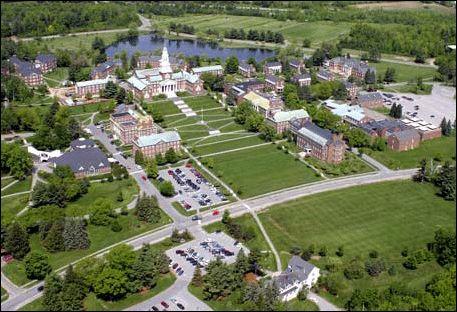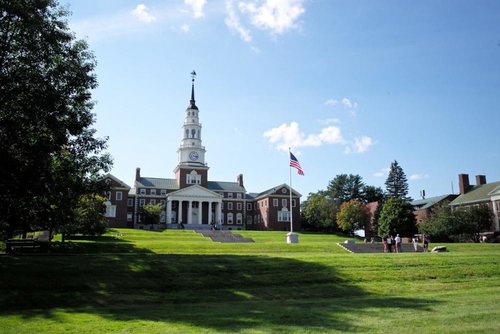Three Methods Applied to the Colby Campus
November 29, 2018
by Katherine Melcher, Cohort ’16

.jpeg)

- Aerial view of Colby College Campus’ Academic Quad. (Image Source)
- Historic Plan for Colby College. (Image Source)
- View of Academic Quad with Miller Library in the background. (Image Source)
FORMALIST ANALYSIS
The Colby College campus is laid out on two axes that intersect to form a cross. The Miller Library (the main library) is placed at the intersection of these two axes at what appears to be the highest point on campus. The library divides the cross into four spaces (or quads), each facing a different side of the library. The Academic Quad is by far the largest of these quads. It is framed by academic buildings and rows of oak and maple trees. The buildings are connected by symmetrical sidewalks forming diagonal lines across the quad. A flagpole punctuates the central point of these intersecting sidewalks.
Placed on a steeply sloping site, the quad is terraced, stepping down towards an expansive view of the surrounding hills. What looks like a traditional quad with axial symmetry and focal points becomes unique when it is laid across a steep hillside. The placement of the library at the top of the hill, the stepped terracing of the quad, and the open view, make the quad different from traditional, enclosed campus quads. It is outward-looking and expansive rather than inward-focused.
PHENOMENOLOGICAL ANALYSIS
Visit 1: I sit on a bench. The shade feels cool; the breeze feels warm. My eye is drawn to movement – two gulls waddling next to the flagpole at the center of the lawn. My eyes are drawn upward – a V-shape, a bird flies over a rooftop, crosses the sky, soon followed by multiple pigeons. They fly out halfway across the quad, circle back, and fly out again. I then watch the patterns that the light through the leaves makes on my notebook as the wind blows past. Bees are visiting the clover at my feet. People are not moving, not drawing my eye. I intentionally scan for them. They are sitting on benches on the edges, playing ball, occasionally one or two walk across the lawn. The scuffle of feet, the thwack-thwack of flip flops, the jingle of a key chain passing behind me. Youth chatting, yelling, gets louder, coming from the ball fields. One gull gets tired of waddling and sails away on the breeze. But he circles back.
Visit 2: I cross the quad and climb to the top because I want to experience the views of the hills. I sit again. The wind blows (gently) hair in my face. The flag flops lazily. The sun warms one shoulder, while the breeze cools the other. People crossing back and forth lines straight across the quad. A motorcycle on the road below mimics their movement. Now a car does the same. The humming of a power plant (or some machinery), and occasional blurts of a loudspeaker, bird chirp.
I see four to five subtle ripples of hills going off towards the horizon, some white towers in the distance. The clouds line the horizon, like additional ripples mirroring the hills. Then there is the sky. A few clusters of clouds stretched horizontally across the sky, a crescent moon. Back to my shoulders – one warm, the other blown upon. The shade has left me. A plane flies between the moon and clouds. The cloud clusters have thinned out, almost gone, remarkable in such a short time.
HERMENEUTIC ANALYSIS
“This is what I think a college campus should look like,” exclaimed a colleague as we entered the Academic Quad for the first time. Several elements of the Academic Quad communicate that it is a college campus: the red brick buildings framing the quad, the neo-classical porticos and Grecian columns, and the open lawn lined with shade trees. The lack of certain elements, such as cars (and parking) and commercial spaces, also indicate that it is a college campus. The white steeple and the ship weather vane that top the library, reminiscent of town halls in small New England towns communicate to me that this campus is in New England.
The library is placed at the intersection of the two axes and at the highest point of the campus, indicating its central importance. The chapel is placed on a secondary axis aligned with the library, but also at the top of a hill (a depression runs between the library and chapel), indicating that, although it is not of central importance as the library, it (religion and faith) is on equal footing as knowledge. In contrast, the dining hall (the other end of the secondary axis) is downhill from both the library and chapel, and is therefore not as visually-prominent.
There are also unintended meanings within the materiality of the space. The quad is grandiose, much larger than one would expect for a College of the size of Colby’s. It is a ceremonial space, an expansive space, an outward looking space that wants to impress. One aspect of the quad that indicates a few cracks in this impressive expression of collegiate ideals is the sidewalk. The view is grand, the terraces are navigated by granite steps, but then they are connected with unlined asphalt walks, already showing signs of wear. Cracks and bumps are appearing, the surface is uneven, and in style and material, it feels incongruous with everything impressive that the space is trying to say.
